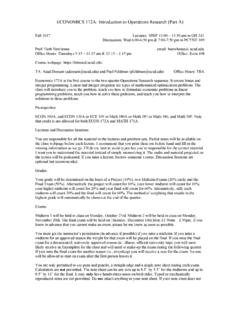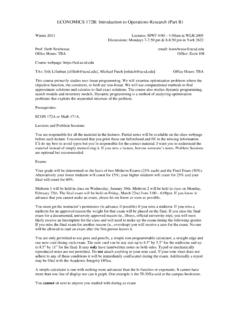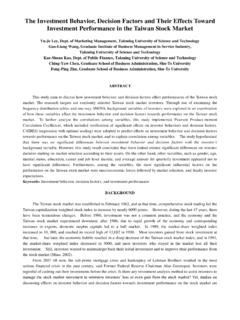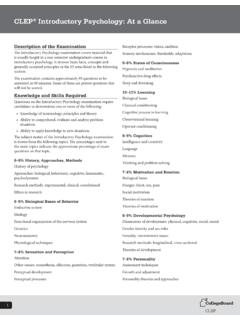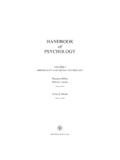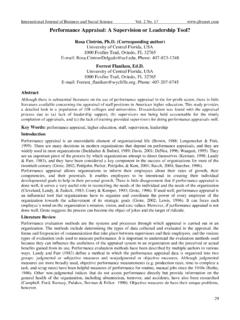Transcription of The DSM-5 Powerpoint - Courses.ucsd.edu
1 4/18/12 1 Russell Kim April 17, 2012 1) DSM-5 : Why a new edition? 2) History The APA and the DSM-5 Task Force The Coalition for DSM-5 Reform 3) Timeline: Where are we now in the process? 4) Field Trials 5) Open Letter to the DSM-5 6) Changes for the DSM-5 Information presented here is admittedly (and unfortunately) biased DSM-5 source Coalition source Any changes are not final (and won t be until next year!) 4/18/12 2 Criticisms of DSM-IV-TR Too many co-morbidities Too many Not Otherwise Specified (NOS) Lack of dimensional assessments Advances in research and knowledge Technology: Neuroimaging era SEXY Push for (keep this in mind) 1999: American Psychiatric Association (APA) & National Institute of Mental Health (NIMH) Experts in: family/twin studies, molecular genetics, basic and clinical neuroscience, cognitive and behavioral science, development throughout the life-span, and disability 2004-2008.
2 13 conferences held 400 world-wide experts from 39 countries Many published articles Current state of knowledge, gaps in research, recommendations for additional research 2006: Dr. Kupfer and Dr. Regier appointed to DSM-5 Task Force David Kupfer, Darrel Regier, 4/18/12 3 2007: 13 Work Groups created 8-15 experts each group (162 total) 97 psychiatrists 47 psychologists 2 pediatric neurologists 3 statisticians/epidemiologists 1 representative each group from pediatric, social work, psychiatric nursing, speech and hearing specialists, and consumer groups Also: 300 outside advisors (volunteer medical and mental health experts) 13 Work Groups.
3 ADHD and Disruptive Behavior Disorders Anxiety, Obsessive-Compulsive Spectrum, Posttraumatic, and Dissociative Disorders Childhood and Adolescent Disorders Eating Disorders Mood disorders Neurocognitive Disorders Neurodevelopmental Disorders Personality and Personality Disorders Psychotic Disorders Sexual and Gender Identity Disorders Sleep-Wake Disorders Somatic Symptoms Disorders Substance-Related Disorders Work Group Duties: 1) Review DSM-IV strengths/weaknesses 2) Literature reviews 3) Develop questions/hypotheses 4/18/12 4 Feb. 10, 2010 : Draft Diagnostic Criteria for DSM-5 Released Feb.
4 2010 -April 2010 : 1st open forum 8600+ comments May 2011-July 2011: 2nd open forum 2000+ comments David Elkins, President (1989-1999) Division 32, Society for Humanistic Psychology of APA (American Psychological Association) Oct. 22, 2011: Open Letter to DSM-5 Task Force Petition quietly posted to 1 week: 2000+ psychologists, counselors, mental health professionals 3 weeks: 6000+ Endorsed by 23 mental health organizations (12 divisions of APA) Notable supporters: Nature News, Medscape, USA Today, Forbes, Newsworks As of this morning?: 12,995 Nov.
5 4, 2011: Task Force Responds Don t worry, we re working on it! Nov. 7, 2011: Coalition Responds to Task Force We re worried! 4/18/12 5 American Counseling Association (ACA) Nov. 8, 2011: Call for external review Main Concerns 1) Revisions lack empirical basis 2) Field trials (will revisit) 3) Definition of Mental Disorder (will revisit) 4) Transparency Confidentiality agreement? Main Suggestions 1) Make reports public 2) Remove revisions that lack empirical evidence 3) Submit evidence/data for external review Nov. 21, 2011: DSM-5 Task Force responds to ACA Task Force addresses 1) Empirical evidence/independent review?
6 DSM-5 Work Groups = external review! 2) Transparency? Confidentiality agreement? Not promoting secrecy Plenty of sharing Jan. 9, 2012: Coalition calls for Independent Review 4/18/12 6 Jan. 27, 2012: APA (American Psychiatric Association) President John Oldham, responds Today: April 17, 2012 April 2010 -February 2012 : Field Trials Large medical centers Smaller, private practices April 2012 (now!): Data analysis from field trials Spring 2012: 3rd (and final) open forum May 18-23, 2013: Release of DSM-5 during APA s 13th Annual Meeting. San Francisco, CA.
7 Purpose: to assess reliability and clinical utility of proposed revisions Validity? Prevalence? Main focus: Test-retest reliability Can two different clinicians, doing independent evaluations of same patient less than 2 weeks apart, come to same diagnostic conclusion? 4/18/12 7 Oct. 22, 2011: 1) Lowering of diagnostic thresholds Problems? More people diagnosed, false positives, stigmatization Ex: GAD, ADHD, MDD (bereavement?) 2) Vulnerable populations Children/adolescents Dangerous medications ( , neuroleptics) Elderly Normal cognitive decline?
8 3) Psychobiological emphasis Roman numerals for DSM edition dropped Past: DSM-II, DSM-III, DSM-IV (DSM-IV-TR) From now on: DSM-5 , , Chapter Reorganization Developmental lifespan fashion Throughout chapters Neurodevelopmental disorders Neurocognitive Disorders Within chapters Within Anxiety Disorders Chapter, Separation Anxiety GAD Specific disorders? Too many to go through right now ( , I haven t looked through them) Definition of Mental Disorder 2 proposed definition changes: Anxiety, Obsessive-Compulsive Spectrum, Posttraumatic, and Dissociative Disorders (Stein et al.
9 , 2010 ) DSM-5 Study Group on Impairment and Disability Assessment In common? Psychobiological dysfunction/disruption Rationale? D. The term psychobiological is used to emphasize the inextricable links between the biological and the behavioral/psychological. As opposed to the DSM-IV: D. A manifestation of a behavioral, psychological, or biological dysfunction in the individual 4/18/12 8 Dimensional Ratings for disorder criteria Purpose: provide richer characterization of patient than previous categorical approach Tracking of a patient s improvement with treatment over time Types of dimensional ratings.
10 Cross-cutting Disorder-specific Cross-cutting dimensions (symptoms that cut across the boundaries of any single disorder, , depressed mood, anxiety, anger, substance abuse, sleeping problems) Encourage clinicians to document all symptoms instead of just those tied to primary diagnosis Before diagnosis (at initial evaluation) Establish baseline to track treatment changes Method of assessment: Patient-completed self-report measure Rate 0-4: not at all to nearly every day ), or Clinician-administered measure Rate 0-4: not present to present and severe ) Disorder-specific dimensions After diagnosis ( , Bipolar I Disorder) Method of assessment: Patient-completed self-report measures, or Global clinician-rated severity measure 4/18/12 9 Roman numerals for edition dropped Chapter Reorganization Specific disorder changes (duh) Definition of Mental Disorder Addition of Dimensional ratings YouTube: 1) How DSM-5 will change your clinical practice (4 videos) - Thank you!
